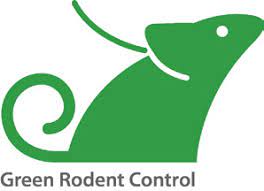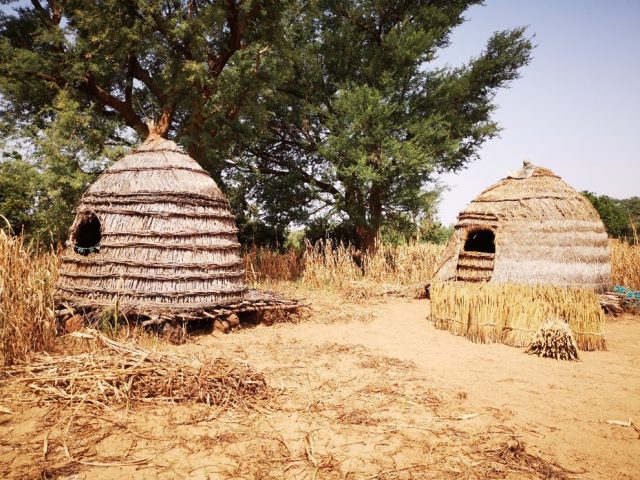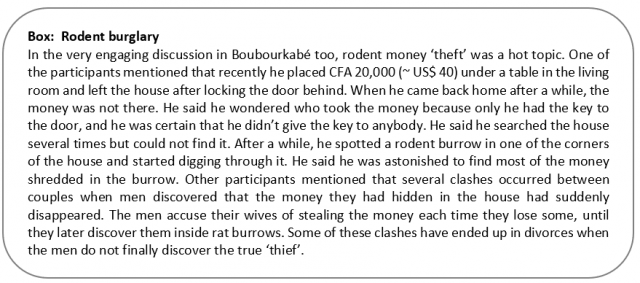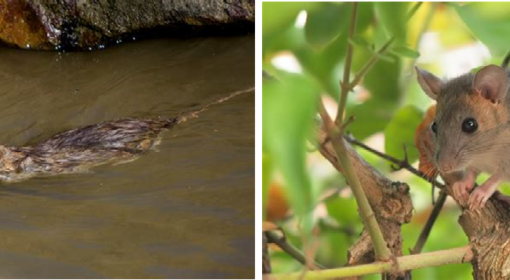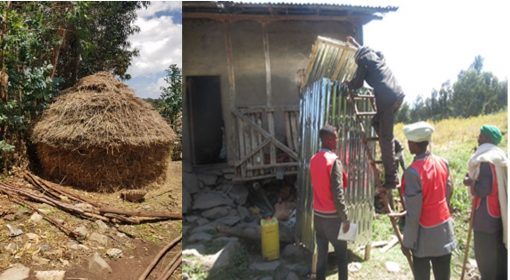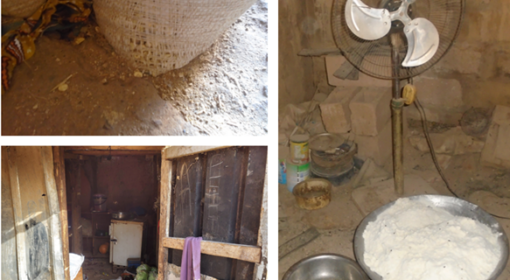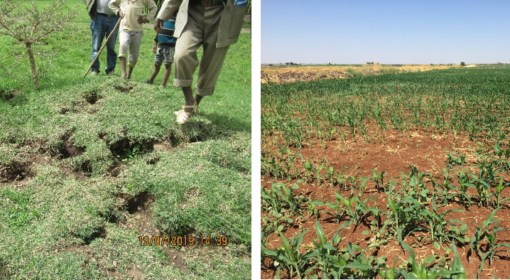- Meheretu Yonas & Luwieke Bosma, MetaMeta Research and Rodent Green, Wageningen, The Netherlands
- Karmadine Hima, Abdou Moumouni University, Niamey, Niger
- Madougou Garba, Ministry of Agriculture, Niamey, Niger
- Gauthier Dobigny, French Institute of Research for Sustainable Development (IRD), UMR Centre for Biology for Population Management (CBGP) France.
Rodents in agriculture and public health
In the economy of Niger, agriculture is a major component. Some key numbers: it contributes 42% of gross national product, 44% of export revenues (including livestock), and 85% of employment (ROPPA, 2019; INS/MP, 2020; MAG/EL, 2020). This is a high dependency on agriculture, despite a tenuous resource base. Niger shares this with other Sahelian countries.
Agriculture is fragile in itself. For one, it suffers heavily from pest infestations across the value chain, including insects, birds (especially the red-billed Quelea quelea) and rodents (Dobigny et al., 2001). The main cereal crops in Niger are millet, sorghum, rice, wheat, and maize. Anecdotal estimates indicate that pre- and post-harvest crop damage and yield losses to these pests in Niger account for between 20-30% annually, though an exact count is missing (see Garba et al., 2014).
In Niger, more than 10 species of rodents (e.g., gerbils, rats, and mice) have been reported as significant pests. In urban areas the most prominent ones are Mastomys natalensis, Rattus, and Mus musculus. In rural areas (both in fields and storage) it concerns Gerbillus nigeriae, G. nanus, Jaculus jaculus, Mastomys erythroleucus, and Arvicanthis niloticus, and to a lesser extent Cricetomys gambianus, Desmodilliscus braueri, Gerbilliscus spp., Xerus erythropus, and Taterillus spp. (see Dobigny et al., 2001 for details).
Rodents do not only harm crop yields, but also cause diseases. Rodent-borne zoonoses (a disease transmitted by rodents to humans) have been studied in small mammals from Western Niger, especially in the Niamey area. They include leptospirosis that was found around garden market agriculture (Dobigny et al., 2015) and toxoplasmosis (Mercier et al., 2013). Rodents in Niger also carry the infamous ‘sleeping sickness’, i.e., trypanosomiasis, normally associated to tsetse flies and livestock (Dobigny et al., 2001; Tatard et al., 2017; Rossi et al., 2018). Other studies have pointed towards the presence of pathogenic bacteria genera such as Helicobacter, Orientia, Mycoplasma, Streptococcus, and Ignatzschineria (Dobigny et al., 2015). Gastro-intestinal helminths have also been identified in some urban small mammals from the capital city (Diagne & Dobigny, unpublished). Clearly, rodents affect the well-being and health of communities and are behind many sometimes ambiguous but crippling health problems (nausea, fever, diarrhoea, weakness). In neighbouring countries rodent-related pathogens such as Rickettsiales, hantaviruses, and Lassa virus occur. These may be carried by Nigerien rodents as well.
Public perceptions
Despite their widespread effects, understanding of rodents is limited. On a recent visit to Gamkalleye sub-city in Niamey (26 Oct. 2021; Fig. 1) and the rural village of Boubourkabé near Niamey (27 Oct. 2021), we had very engaging discussions with the Chiefs and community representatives. The discussions were mainly focused on understanding public perceptions on rodent-related agricultural and public health problems the communities are facing. Interestingly the participants were very fascinated by the subject matter discussed and straight away mentioned that such an issue has never been a topic of discussion among members of the communities. Some of them talked openly about their personal experiences with rodents at home, personal property they have lost to rodents, and health hazards posed by rodents. Here is what the Deputy Chief of Gamkalleye, Mr Oumarou Garba, said during the meeting: ‘In the name of God, I know how horrible rodents are in fields and storage areas, but it is now for the first time that I heard about they are being carriers and transmitters of diseases to humans and that diseases could be contracted by consuming food or cereals contaminated with rodent urine and faeces. I didn’t know that before. I think these animals are serious problems for our community in many ways and we need to do something about it collectively. There were instances where I lost money from my home and ended up finding it in rodent burrows after some time. They like to carry money to their burrows and eat it there.’ (See box for more on similar notes).
At the end of both discussions, the participants elected five men and three women as contact persons (community representatives) for future rodent related activities and collaborations. The discussions made it clear that rodent-associated problems are felt acutely among members of the communities, whether it was in the form of field and storage losses or household property damage, and that they would like to do something about it (see also Garba, 2012; Garba et al., 2014;). At the same time, it was evident that members of both communities lacked knowledge on the public health effects of rodents. In the end, they called for some entities (private citizens, NGOs or GOs) to help them organize themselves, get trained on how to manage rodents in a better way and which actions they need to take collectively against rodent pests.

Observation in crop fields and storage
In Boubourkabé village we got the chance to visit harvested millet fields and granaries built in these fields to store millet and sorghum grains (Fig. 2). The granaries are made up of wooden sticks and grass, clearly far from being rodent-proof storage. We noticed signs of rodent activity inside and outside the granaries (Fig. 3). In fact, unprotected granaries placed in the middle of the fields amount to ‘a feast for the rodents.’ There is always ample food either in the field or in the granary. If the rodents cannot feed on the standing crop, they can survive and thrive in the grain storage placed in the middle of the fields. Inside houses, grains are stored mainly in polyethylene bags which are economically affordable but highly susceptible to rodent attack. In terms of rodent management locally, unfortunately, nothing is happening, except that some farmers rely on anticoagulant rodenticides purchased from the local markets. Alternative rodent management methods are not available.
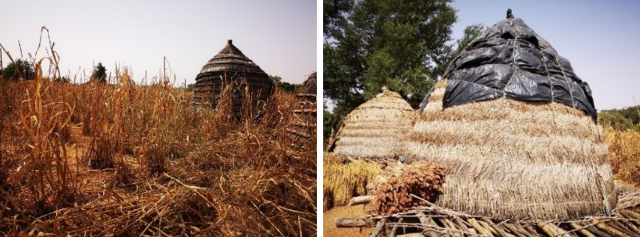

Way forward
There is still much unknown. Empirical data on field and storage losses to rodents is lacking in Niger. It would be useful to fill these knowledge gaps and have an inventory of local rodent management practices. It is also important and urgent to test a number of tailored ecologically based rodent management actions.
1. Better storage
The grain storages are now at the heart of the rodent damage. We believe that cereal farmers in Niger are losing significant quantity of their grains to rodents by storing in polyethylene bags and granaries which have proven time and again to be ineffective against rodents and make it possible for rodents to sustain their population throughout the year. Therefore, it is necessary to innovate, adapt / adopt better grain storage materials, such as hermetic bags, metallic silos, and rodent-proof granaries to reduce the impacts of grain attack by pest insects and rodents. We believe the practice of grain storage in the middle of the fields should change, in consultation with communities. We also recommend tests on the effectiveness of some hermetic bags against these pests in the Nigerien context (taking into account the weather, rodent species, and storage systems) and damage estimation to fill the knowledge gap.
We recommend an experimental trial that represents an urban situation. Gamkalleye, part of Niamey, would an ideal trial site. The target rodent species would be Rattus, Mastomys natalensis, Mus musculus, and Arvicanthis niloticus; and the target grain shall be rice and/or maize. For the rural trial, the setup in Boubourkabé village is ideal, as it has a mix of cropped fields, outdoor granaries, and rural settlements. Here the experimental grain could be millet and the target rodent species would be Mastomys erythroleucus, Rattus and Arvicanthis niloticus.
2. EBRM trials around granaries in Boubourkabé
A range of EBRM (Ecologically Based Rodent Management) actions could be trialed around the granaries in Boubourkabé by setting up, for example, two independent locations (control and experimental) where rodents would be trapped on a monthly basis in the presence and absence of tailored EBRM actions. The actions may include community awareness campaigns, sustained community rodent management campaigns involving cleaning around granaries for rodent harbourage, sustained trapping (e.g., monthly trapping campaigns), destroying and flooding burrows, runways, attracting natural predators (e.g., installing raptor perches), installing movement interrupters (e.g., rodent baffles and collars on the pillars of the granaries), improving standard of granaries by adding rodent-proof materials at the base and sides of the granaries (e.g., corrugated iron sheet), and applying bio-rodenticides. Since the granaries are located in crop fields (not in homesteads), it is possible to spot taxa such as Gerbillus, Jaculus, and Taterilus around in addition to the storage rodent taxa mentioned above.
3. EBRM trials in urban homesteads in Gamkalleye
EBRM would also need to be introduced in urban and peri-urban settings and make it part of neighbourhood development. This is a new thing in Africa, and it is likely to pose a wide range of challenges not encountered in rural EBRM. This trial in Gamkalleye would be the first of its kind at least on the African continent. The EBRM actions which could be trialed here may include:
- Community awareness creation, followed by
- Sustained community rodent management campaigns
- Ensuring regular inspection of houses, storage areas, gardens, shops, and other occupational areas
- Sustained cleaning of houses and compounds for rodent harbourage and domestic waste, refuse, wood piles, stone piles, bushes, and unnecessary vegetation
- Disposing domestic and other waste appropriately (establish a system)
- Sustained trapping (e.g., monthly trapping campaigns)
- Destroying and flooding burrows, runways, harbourage, climbing spots, tracks, etc.
- Encouraging cats as pets (many households have them already) and attract other natural predators (e.g., install raptor perches)
- Immediately repairing openings in the house/storage where rodents passthrough
- Installing rodent disruptors on rodent runways, escape routes, …
- Using/manufacturing rodent-proof materials
Acknowledgement
The recent visit of MetaMeta staff to Niger was financially supported by funds obtained from the French Institute of Research for Sustainable Development (IRD) and core funds of MetaMeta. We thank MetaMeta Research, Rodent Green Company, Abdou Moumouni University, and the Nigerien Ministry of Agriculture for permitting staff exchange and organizing local travels and activities in Niger.
References
Dobigny, G. (2001). Inventaire et biogéographie des rongeurs du Niger: nuisances au cultures, implications dans certains problèmes de santé publique et vétérinaire. Rapport de Coopération, CSN, IRD, 71 pp. [in French].
Dobigny, G., Garba, M., Tatard, C., Loiseau, A., Galan, M., Kadaouré, I., Rossi, J.P., Picardeau, M., Bertherat, E. (2015). Urban market gardening and rodent-borne pathogenic Leptospira in arid zones: a case study in Niamey, Niger. PLoS Tropical Neglected Diseases, 9(10), e0004097.
Garba, M. (2012). Urban rodents and biological invasion in southwestern Niger: community ecology and population genetics. PhD Thesis, Abdou Moumouni University, Niamey, Niger, 261 pp.
Garba, M., Kane, M., Gagare, S., Kadaoure, I., Sidikou, R., Rossi, J-P., Dobigny, G. (2014). Local perception of rodent-associated problems in Sahelian urban areas: a survey in Niamey, Niger. Urban Ecosystems, 7, 573–584.
INS/MP (2020). Annuaire statistique du Niger, Institut National de la Statistique/Ministère du Plan, République du Niger. 257 pp. [in French].
MAG/EL (2020). Revue annuelle conjointe 2019 du secteur Agriculture-Élevage. Ministère de l’Agriculture et de l’Élevage, République du Niger. 122 pp. [in French].
Mercier, A., Garba, M., Bonnabau, H., Kane, M., Rossi, J.P., Dardé, M.L., Dobigny, G. (2013). Toxoplasmosis seroprevalence in urban rodents: a survey in Niamey, Niger. Memorias do Instituto Oswaldo Cruz, 108(4), 399-407.
ROPPA (2019). Réseau des Organisations Paysannes et des Producteurs de l’Afrique de l’Ouest : le secteur agricole au Niger, 103 pp. [in French].
Rossi, J.P., Kadaouré, I., Godefroid, M., Dobigny, G. (2018). Landscape epidemiology in urban environments: the example of rodent-borne Trypanosoma in Niamey, Niger. Infection, Genetics and Evolution, 63, 67-75.
Tatard, C., Garba, M., Gauthier, P., Hima, K., Artige, E., Dossou H.J., Gagaré, S., Genson, G., Truc, P., Dobigny, G. (2017). Rodent-borne Trypanosoma from cities and villages of Niger and Nigeria: a special role for the invasive genus Rattus? Acta Tropica, 17, 151-158.
Recommended citation: Meheretu, Y., Hima, K., Garba, M., Bosma, L., Dobigny, G. (2021). Protecting the granary: the need for Ecologically Based Rodent Management in Sahelian Niger. MetaMeta Research and Rodent Green, Wageningen, The Netherlands. (https://thewaterchannel.tv/thewaterblog/protecting-the-granary-the-need-for-ecologically-based-rodent-management-in-sahelian-niger/)
